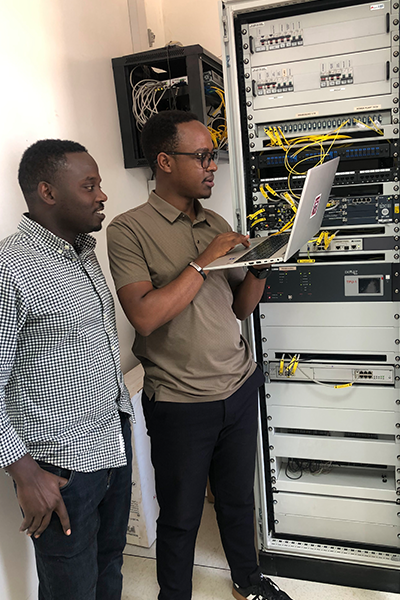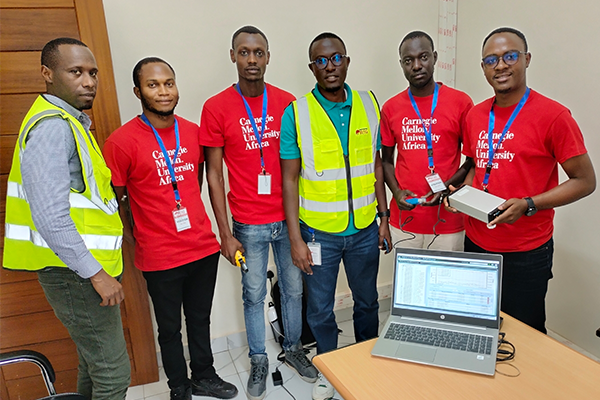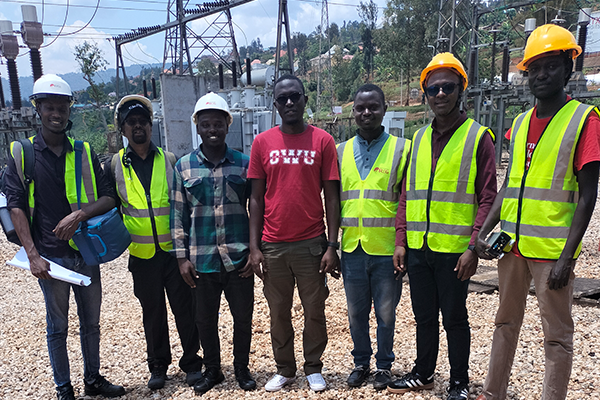Powering the future
Staff writer
Jun 9, 2025
Researchers from Carnegie Mellon University Africa are making strides in power system reliability and monitoring by using phasor measurement units (PMUs) to gather data on the health and behavior of the Rwandan energy grid. The initiative marks a major step forward in real-time analysis, providing the means to improve stability, efficiency, and fault detection for the power grid.
Over the past few months, a CMU-Africa research team has worked closely with engineers from the Rwanda Energy Group (REG) to strategically deploy PMUs across key locations in the power network. PMUs provide precise, time-synchronized measurements of voltage and current phasors, offering valuable insights into grid performance.

Source: Jasper Kwizera
Jasper Kwizera (right) configures the communication channels for data streaming from a computer connected to a phasor measurement unit.
The researchers hope to take advantage of the information from the PMUs to identify weaknesses in the grid and ultimately improve the dependability of the power supply for customers in Rwanda. Data from the PMUs will highlight where the grid needs to be reinforced and extended, and could enable the detection of potentially disruptive oscillations. PMUs placed at customer locations, for example, serve to record places where there are possible reliability issues in the grid.
The team has also successfully installed PMUs at several electrical substations, which moderate voltages from power-generating stations before the energy is distributed to consumers. These substations include Jabana Substation; Shango Substation, which monitors flow between Uganda and Rwanda; Mamba Substation, which monitors an 80 MW peat power plant; and Shema Power Lake Kivu, which monitors a 50 MW methane gas power plant.
"The devices installed at power plants are enabling engineers to closely study the behavior of some generators so that their interaction with the rest of the system can be improved," says Jasper Kwizera (MS ECE '25), a member of the research team.
Other PMUs installed by the team are monitoring the interconnection between the Rwandan and Ugandan grids. The phasor measurement technology will be beneficial for Rwanda’s participation in the Eastern African Power Pool, a regional power pool that aims to optimize the efficiency and sustainability of energy generation and transmission for the 11 countries currently participating.
"The availability of live and detailed historical records are critical for tuning the models that engineers use to ensure the stability of the grid," says Jasper. "They can also document the changing character of the grid as it grows and interconnects with more countries."
The PMUs were installed for a project titled "University Measurement Units: Reliable Integration by the Rwandan Operator," or UMURIRO, which in Kinyarwanda means "light." The UMURIRO researchers include Barry Rawn, associate teaching professor of electrical and computer engineering; Sarath Tennakoon, visiting professor and Kigali Collaborative Research Centre (KCRC) research fellow; and CMU-Africa alumni Jasper, Dieudonne Iradukunda (MS ECE '25), Rock Agon (MS ECE '24), and Ateny Aguto (MS ECE '25).

Source: Jasper Kwizera
From left to right, in Carnegie Mellon University Africa shirts, team members Rock Agon, Dieudonne Iradukunda, Ateny Aguto, and Jasper Kwizera meet with Rwanda Energy Group representatives.
These CMU-Africa researchers are working alongside the KCRC and, in an international collaboration, Queen's University Belfast, which provides funding for the project. The Queen's University Belfast team is led by David Laverty, who pioneered the low-cost, open-source design for PMU devices that is being employed for UMURIRO.
"Working on this project has been a truly enriching experience. Engaging in insightful discussions with REG engineers has broadened our understanding of long-term solutions for power grid stability," Jasper says. "This collaboration has provided me with the opportunity to apply and refine a diverse set of skills, including data analytics and power systems analysis. I take great pride in being part of such a transformative initiative, and I am deeply motivated to contribute my expertise and energy to this long-term endeavor."

Source: Jasper Kwizera
Dieudonne Iradukunda, Sarath Tennakoon, three Rwanda Energy Group representatives, Jasper Kwizera, and Ateny Aguto stand in front of the Jabana Substation.
This collaboration between CMU-Africa and REG is not a one-time effort; it is part of a long-term partnership aimed at enhancing the resilience and operational intelligence of the power system. In the future, additional advancements like automatic event detection and LLM-based data querying could facilitate and enhance human-machine collaboration to secure the stable and secure operation of Rwanda’s power grid.
The next phases of UMURIRO will include enhancements in data analysis, installation of additional PMUs, and further refinement of monitoring capabilities, as the collaborators continue to push the boundaries of innovation in power system monitoring.